ARTICLE

Twenty-two birds are the major arcana of a lunar? deck to watch carefully, as birds do.
Birds Tarot (2018) by the illustrator Fiona Marchbank (United Kingdom, Virgo) includes quite diverse birds. Like in first ancient Tarot decks, there are only 22 major cards.
I. The cards
The gallery below displays the cards along with a brief description of the species chosen by the author, as well as other drawings she included in the designs.
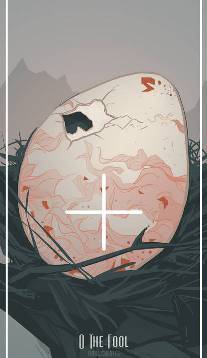

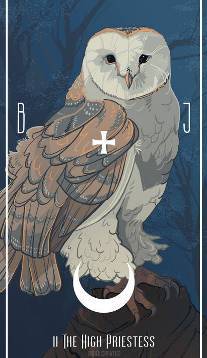


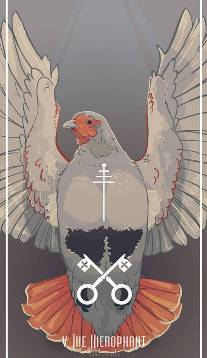
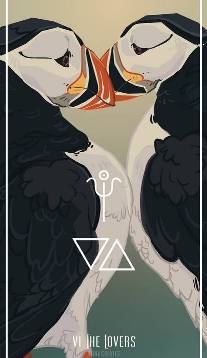
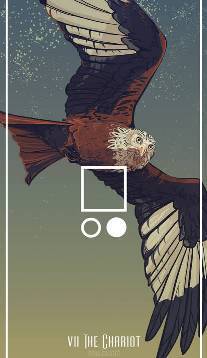


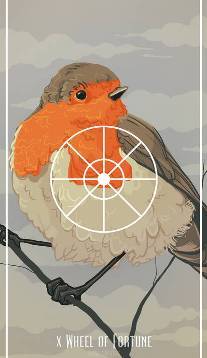
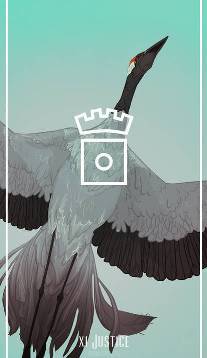
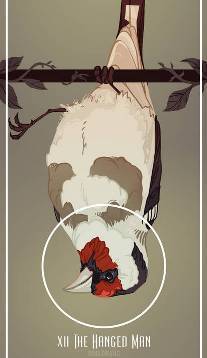
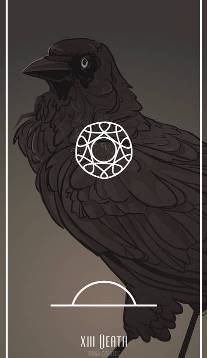
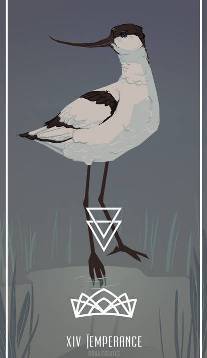
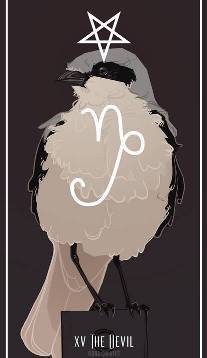
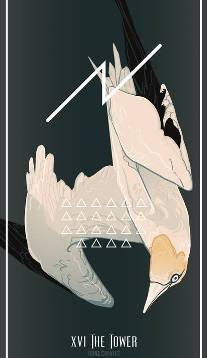
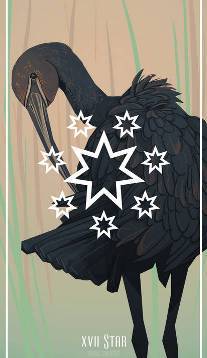
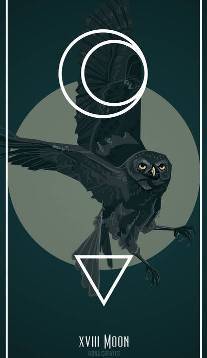
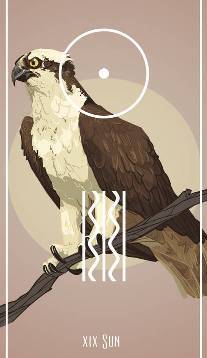
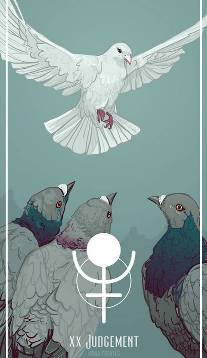

II. Perspectives and relations
We have to look at Fiona's deck by wondering: is the bird in motion or landed? Where is it oriented to? Where are their paws? By perceiving these characteristics, the birds acquire meaning and show themselves as being part of groups, as we also find other strange relations between cards.
One common characteristic of all of the birds is that they actually look at us or, at least, we're inside of their vision angle. Exceptions are The Fool (there's no chaffinch or is not visible), the wagtail in The Empress (she's looking at its own eggs, and we look at it from above), the puffins in The Lovers (they look at each other, and we have one-side vision of them), and the crane in Justice (we don't see its eyes).
Birds are usually flying or landing, or standing on mountains or peaks of rocks, posed on branches, near water, among reeds or inside nests.
| The 12 birds on feet can be seen across a 180° dynamics according to their heads' turn. For example: only the arctic tern in The World turns completely the head to our right side, although the robin in The Wheel of Fortune is 45° oriented (on the same orientation), and the owl in The Priestess straightly looks at the watcher. Staying on the same orientation (to the left side), then we also find 8 birds with their heads turned 45° to the The Priestess (or watcher), whereas the gull in The Hermit is completely 90° oriented (so it remains opposed to the tern in card XXI). Fiona's deck places cards in such a distribution that The Hermit and The World are contrary to each other. | 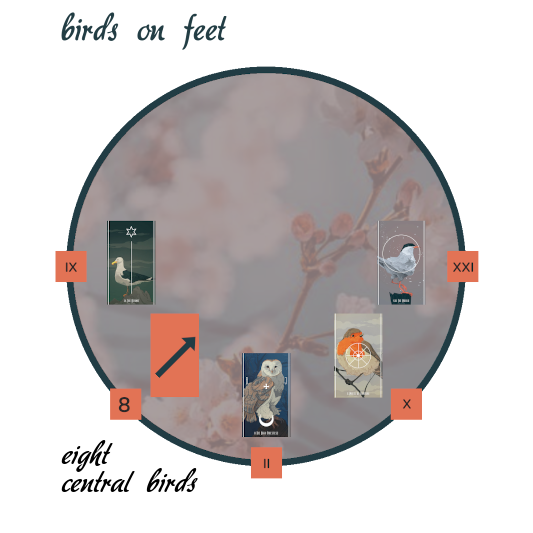 |
In the group of 8 landed birds at 45°, the golden eagle (IV) is on a rock; the goldfinch (XII) and the osprey (XIX) are on branches; the egret (VIII), the crow (XIII) and the ibis (XVII) don't show where they're standing on; the avocet (XIV) is on water; and the shrike (XV) is on an element hard to identify.
Like the other birds, the group of 8 as a whole stand on the perimeter, at a 45° vision angle (between The Hermit and The Priestess) but, if we read them one by one, we should consider them as not being on the perimeter but in the spaces or areas in between cards, like mediators or rulers of those other angles of vision. The 8 birds are part of a special sub-group, to be placed in a singular area, for example in the central drawing we see in The Wheel of Fortune in card X (the circle surrounding the central part).
| The area to place those cards is not set according to where the bird stands on but other elements in the card. If you look at them, you'll see the 8 birds are paired as opposite ones: how would you connect the osprey in The Sun to the shrike in The Devil? What is the relation between the golden eagle in The Emperor and the crow in Death? | 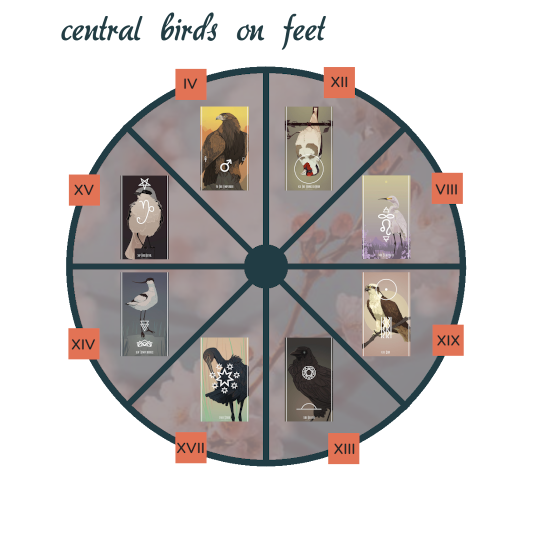 |
Now leaving behind the 12 landed birds, we find 7 flying birds, with 4 of them going towards the main cardinal points: the magpie to the West or left side of the watcher (The Magician), the owl to the East or right side (The Chariot), the crane goes up (Justice) and the ganner is on a hunt (The Tower). The other 3 flying birds are landing: the partridge is facing the watcher (The Hierophant), the pigeon is at 45° to our right side (Judgement), like a middle card between the partridge (V) and the owl (Moon at 90° to the right).
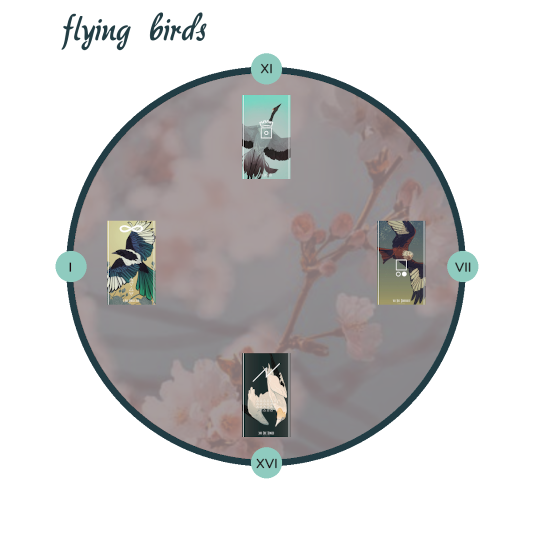
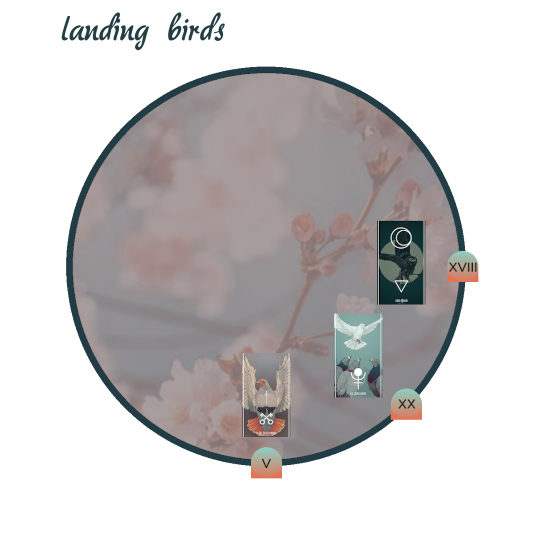
Each orientation indicates basic cards relations, depending on the type of motion. For example: if you get The Magician (I), you have to read it as opposite to The Chariot (VII), and the same goes for Justice (XI) related to The Tower (XVI); whereas Judgement (XX) has to be considered as a middle-way card, a connector or intermmediary between The Hierophant (V) and Moon (XVIII), which might be somehow related to the matter you're interested in.
A special card is The Lovers (VI), where we find puffins. Since they face each other, the card includes two orientations (opposites), so both landed birds should be associated to the tern (XXI) and the gull (IX).
Each group of cards (flying birds, landing birds, stand up) is part of a specific scheme that we may refer to angular relations on birth charts:

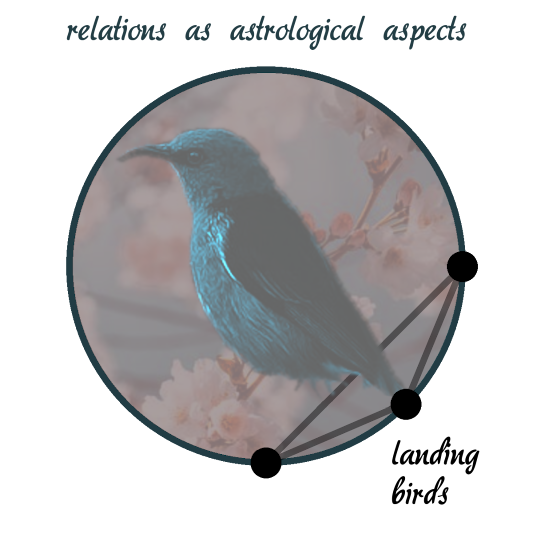
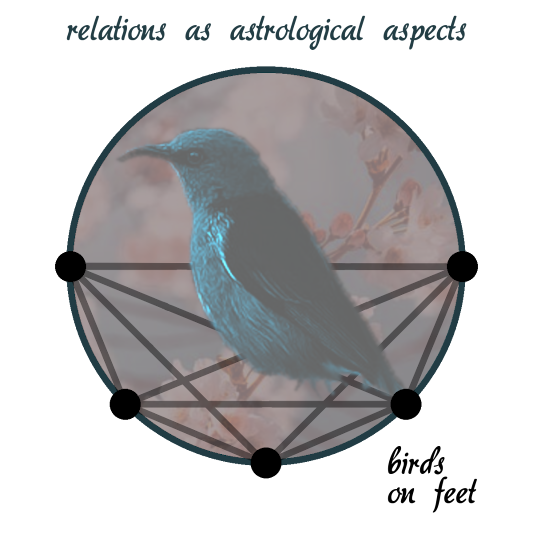
- birds not looking at us: 0 (not visible) - III (on feet) - XI (on a flight)
- flying birds:
- to 4 directions: I (West) - VII (East) - XI (up) - XVI (down)
- landing motion: in the 2nd quadrant: V (0°) - XX (45°) - XVIII (90°)
- landed birds:
- IX - XXI (180°)
- [IV - VIII - XII - XIII - XIV - XV - XVII - XIX] - X (90°)
- IX - X , [IV - VIII - XII - XIII - XIV - XV - XVII - XIX] - XXI (135°)
- II in the middle point between IX and XXI (90°, in a T square)
sets of cards
- The Hermit and The World (landed) are two middle points in the conflict between Justice and The Tower (on a flight), and vice-versa; the four cards are part of a grand cosmic cross
- The Priestess (landed bird) is the middle point in the conflict between The Magician and The Chariot (on a flight); the three cards form a T square
- Justice (on a flight) is the middle point in the conflict between The Hermit and The World (landed birds); they also form another T square
- the group of central ones (8 landed birds) are in tense relations with flying birds (Justice, The Chariot), a landing bird (Moon) and another landed bird (The World); Justice is in a tense relation with Judgement (landing) and The Wheel of Fortune (landed); Judgement and The Wheel of Fortune are in a tense relation with The Magician (on a flight) and The Hermit (landed); all of these relations are 135°, an aspect that will be mentioned in the next item
tensions
| Considering the groups' meetings, then the puffins in The Lovers that were associated to the gull (IX) and the tern (XXI), are now also associated to another opposition: that of the gannet in a descending flight in The Tower and the crane in an ascending flight in Justice. Card VI would be placed in the central area, since is the one representing itself the oppositions of perpendicular axes: an axis to fly (XI - XVI) and an axis to stand or land on (IX - XXI). |  |
III. Dynamics in relations
You'll find many other relations if reading sequences of cards in clockwise orientation (and counter-clockwise, too). For example: there's a dynamic sequence of the owl in The Chariot, that flies closer to the arctic tern in The World although lands as a black owl in Moon card. In the time sequence (clockwise), it will find on its way the osprey in The Sun (one of the landed birds in the group of 8, and ruling that area). Later, it will find the English robin in The Wheel of Fortune (another landed bird) at the end of a judgement that involves the partridge (V) and the black owl (XVIII), since the white pigeon in card XX is landing on The Wheel.... Another dynamic relation in the axis where birds stand on shows the flight of the magpie in The Magician, without landing and overflying the gull in The Hermit. Finally, a descending dynamics involves the gannet in The Tower going down as if hunting the owl in The Priestess, although it lands as a partridge in The Hierophant.
 About the aspects involving points of view (perimeter), you've seen now that the cards are distributed like the lunar cycle as an 8-phase cycle. If you don't know it, it describes the birth, growth, development and decline of a seed (and 4 more intermmediate times). In the image, it starts on the left extreme with the new Moon, and goes counter-clockwise. Each new phase begins after transiting 45° in the arch perimeter: new Moon, new waxing Moon, waxing Moon, gibbous waxing Moon, full Moon, gibbous waning Moon, third quarter, and waning Moon.
About the aspects involving points of view (perimeter), you've seen now that the cards are distributed like the lunar cycle as an 8-phase cycle. If you don't know it, it describes the birth, growth, development and decline of a seed (and 4 more intermmediate times). In the image, it starts on the left extreme with the new Moon, and goes counter-clockwise. Each new phase begins after transiting 45° in the arch perimeter: new Moon, new waxing Moon, waxing Moon, gibbous waxing Moon, full Moon, gibbous waning Moon, third quarter, and waning Moon.
Inside of the cycle, the group of 8 central birds (considered as a whole) would be related to the new waxing Moon (at 45°, between The Magician or The Hermit in the new Moon, and The Tower, The Hierophant or The Priestess in the waxing Moon). In the same crescent lunar hemicycle, The Wheel of Fortune and Judgement would be related to the gibbous waxing Moon (135°), and the full Moon would be represented by The Chariot, Moon and The World. In the second hemicycle, Justice would be the third quarter (270°), although we see there are two phases with no perimeter rulers (gibbous waning Moon at 240° and waning Moon at 315°).
The group of 8 central birds doesn't just rule the new waxing Moon but also the areas between phases (one card by area). For example, if we get The World next to The Wheel of Fortune, then we should read the subject as the full Moon moving away from the axis where it stands on (horizontal line) and coming back to the gibbous waxing phase, by going through situations related to The Sun (the osprey rules the area between those phases).
The following video summarizes the cards distribution according to the 8-phase lunar scheme and the different birds groups assigned to and between them.
IV. Relations in Astrology
The 8-phase lunar cycle implies several types of astrological relations to get familiar with, so we may take them into account in spreads. Planets relate to each other according to arch distances: at 0° (conjunction), 45° (semi-square), 90° (square), 135° (sesqui-square) and 180° (opposition).
0° Conjunction...
It indicates the combination of qualities, events and actions in some specific area. There's a kind of mixture of variable intensity although both planets "go together": where we find one of them, we find the other one too (with greater or lesser visibility). We see the aspect between...
- The Hermit and The Magician
- The Priestess, The Hierophant and The Tower
- The Chariot, Moon and The World
- the 8 central cards
- Judgement and The Wheel of Fortune
// Parallel...
It's similar to the conjunction, and we find it by folding the chart's Eastern hemisphere with the Western hemisphere. The Eastern one is birth into this world (sunrise, the rising Sun or new Moon in the deck's distribution, from third quarter to waxing Moon). If planets are "together" when folding the birth chart, they form a parallel.
- The cards include parallel stroke lines near the right and left borders, and the aspect especially refers to the group of 8 central birds: besides the couples relations to rule areas, we find a parallel aspect between:
- The Star and Death
- Temperance and The Sun
- The Devil and Strength
- The Emperor and The Hanged Man
45° Semi-square...
It means constrictions coming from the "objective world", oppression, frustrations, doubts, uncertainty, fears, confusion and nagging inner conflicts. These are the characteristics of all of the cards related in that arch distance. Due to the lunar distribution scheme, all of this is an intrinsic meaning of each card, and becomes more intense if those ones involved are next to the other one in a spread.
- The Chariot, Moon and The World related to The Wheel of Fortune and Judgement
- The Wheel of Fortune and Judgement related to The Priestess, The Hierophant and The Tower
- The Priestess, The Hierophant and The Tower related to any of the 8 central cards
- any of the 8 central cards related to The Magician and The Hermit
90° Square...
It's the angle of widest separation and big estrangement about other people's qualities. The birds have chosen quite different paths, and find almost no mutual reference but the fact of being born into the same world. As time passes by, estrangement increases and is even harder to find something to share. It's the relation between all of the cards placed on the extremes of perpendicular axes.
- between The Hermit or The Magician, and The Priestess, The Hierophant or The Tower
- between The Priestess, The Hierophant or The Tower, and The Chariot, Moon or The World
- between The Chariot, Moon or The World, and Justice
- between Justice, and The Hermit or The Magician
- between any of the 8 central cards, and Judgement or The Wheel of Fortune
135° Sesqui-square...
It's mainly associated to obstacles, demands and requirements, coming from "the real world" either; ideals, imagination and over-confidence would be problematic traits if we stand alone against the world. This type of relation can be found between...
- The Chariot, Moon and The World related to any of the 8 central cards
- any of the 8 central cards related to Justice
- Justice related to The Wheel of Fortune and Judgement
- The Wheel of Fortune and Judgement related to The Magician and The Hermit
180° Opposition...
It's the most polarised angle across space. It's like an alternating move to balance weights in the extremes, periodically. In the deck's distribution, we find the angle in...
- the horizontal axis where birds land on: between The Hermit or The Magician, and The Chariot, Moon and The World
- in the vertical axis where hey fly: between The Priestess, The Hierophant or The Tower, and Justice
- in the rulers' areas: The Star - The Hanged Man, Death - The Emperor, The Sun - The Devil and Strength - Temperance.
Anti-parallel...
It's similar to an opposition, and we find it by folding the chart's North Hemisphere with the South one. The North one starts with the 1st House (Moon's waxing hemi-cycle in the deck). If planets are "together" when folding hemispheres, they form an anti-parallel aspect.
- Temperance and The Devil
- The Star and The Emperor
- Death and The Hanged Man
- The Sun and Strength
By considering these basic relations, we may find patterns if at least 3 planets are related by at least 2 different aspects. If cards were planets, then the deck could be related to several patterns.
 A T square is formed by two planets in opposition and a third one at 90° to each of them (for example, The Magician, Justice and The Chariot). It produces a big amount of tension, especially falling on the planet with two squares. The ruler of the opposite area to it is usually useful to channel the energy more fluently (in the example, opposite cards to Justice are The Tower, The Hierophant and The Priestess).
A T square is formed by two planets in opposition and a third one at 90° to each of them (for example, The Magician, Justice and The Chariot). It produces a big amount of tension, especially falling on the planet with two squares. The ruler of the opposite area to it is usually useful to channel the energy more fluently (in the example, opposite cards to Justice are The Tower, The Hierophant and The Priestess).
 Another pattern is the grand cosmic cross, formed by a couple of oppositions with squares connecting the at least four planets involved (for example, between The Magician, The Hierophant, Moon and Justice). The configuration creates big tensions although, at the same time, provides great potential, creativity and dynamics that generate constant motivation and motion.
Another pattern is the grand cosmic cross, formed by a couple of oppositions with squares connecting the at least four planets involved (for example, between The Magician, The Hierophant, Moon and Justice). The configuration creates big tensions although, at the same time, provides great potential, creativity and dynamics that generate constant motivation and motion.
Other three patterns are very important and involve 45° perspectives, although these relations must be avoided or prevented in a reading. The patterns are formed by at least:
 a sesqui-square (135°), a square (90°) and a semi-square (45°), for example between The Hermit, The Star and The Wheel of Fortune. To the meanings mentioned above, we have to add a strong detainment and lack of progress over time, misunderstanding people and ourselves, all types of incompatibilities (about experiences, about perspectives) and propagation of problems at the base; all of this usually produces a big paralysis in life situations, mainly related to physical experiences
a sesqui-square (135°), a square (90°) and a semi-square (45°), for example between The Hermit, The Star and The Wheel of Fortune. To the meanings mentioned above, we have to add a strong detainment and lack of progress over time, misunderstanding people and ourselves, all types of incompatibilities (about experiences, about perspectives) and propagation of problems at the base; all of this usually produces a big paralysis in life situations, mainly related to physical experiences a grand negative pattern formed by an opposition between Justice and The Priestess, both related to The Star and The Wheel of Fortune (the two last ones form a square, semi-squares with The Priestess and sesqui-squares with Justice); the final pattern is theoretically among other positive ones (a kite and a boomerang), and indicates to concentrate all the negative energy on the planet in between semi-squares (The Priestess)
a grand negative pattern formed by an opposition between Justice and The Priestess, both related to The Star and The Wheel of Fortune (the two last ones form a square, semi-squares with The Priestess and sesqui-squares with Justice); the final pattern is theoretically among other positive ones (a kite and a boomerang), and indicates to concentrate all the negative energy on the planet in between semi-squares (The Priestess) another negative pattern is formed by a square (90°) involving at least two planets and a third planet forming sesqui-squares (135°) with both, for example Justice and The World in a square, and The Star at 135° to both cards; the pattern especially subtracts dynamics, fluency, vitality, development and projections for the future; in summary, it cuts off pathways and causes impediments that will be very hard to be removed
another negative pattern is formed by a square (90°) involving at least two planets and a third planet forming sesqui-squares (135°) with both, for example Justice and The World in a square, and The Star at 135° to both cards; the pattern especially subtracts dynamics, fluency, vitality, development and projections for the future; in summary, it cuts off pathways and causes impediments that will be very hard to be removed
V. Comments
Certainly, Fiona's deck is a quite singular deck. On one hand, it provides a system of regencies (lunar phases and areas between them) inside of several dynamics (the clockwise time sequence, the counter-clockwise orientation, an overflying sequence in new Moon, and three sequences of flying - landing - standing on the perimeter, between the waxing Moon and full Moon).
About the lunar cycle, the deck is mainly focused on the first hemicycle which is characterized by growth, since there are no cards ruling the gibbous waning phase and waning Moon. But there are other more specific details showing contradictions about the way to represent rulers inside of a cycle that provides life to Earth. For example:
- new Moon (associated to birth or the beginning of new life) is represented by a landed gull that is half-way between the top and the bottom of a mountain;
- waxing Moon (associated to leaves growth) is represented by an already developed owl landed on the top of a rock (The Priestess);
- an only grand pattern concentrates all of the negativity in the waxing moon, annulling physical growth and followed by the crow in Death
- full Moon (associated to development) is represented by a tern landed on a cut trunk (The World); in a cycle of increasing light, this would be the result of the dynamics of flights and landings in the chart's 2nd quadrant; since it's the only bird completely oriented towards the right side (which is the classic reference about upcoming times), the deck is indicating the future starts from those circumstances (we don't know what future is but is certainly not that of the second hemicycle); another way to read the dynamics of flights and landings, more related to real birds' motion, is by following a darkening orientation (clockwise): from the owl's fly (Moon) towards the landing partridge (The Hierophant);
- third quarter (associated to growing roots, in the darkness of the soil, for the next life cycle) is represented by a crane in an ascending flight to heaven (Justice);
- the only two cards that include nests and eggs are not rulers! (a chaffinch's egg in The Fool and the yellow wagtail in The Empress),
The deck is nuclearly antagonistic to its own references (characters and lunar cycle). Firstly, birds are animals related by far to lightness (flight, air) although, from an astrological perspective, they are displayed as characters in a cards scheme of total tension. At the same time, the Moon's cycle as a matrix is lost since it has been reduced to a hemicycle not leading to development, not assigning cards to phases in the waning hemicycle (even the crane in Justice has no roots), and including an absolute most of rulers oriented towards initial phases. Then, we may easily wonder about the broken shell in The Fool: is it a sign of birth or of death of the life about to be born?
Where is the birds' spirit? What about life? These and other questions remain unknown in this first appreciation of Fiona's Birds Tarot.
indexTo contact the artist, you may find her in deviantart.com, Inprnt, Instagram, ArtStation, Ko-fi, LinkedIn, Behance, Tumblr, Etsy o right in her website.
Lunar phases images by ©2010 Fred Espenak in www.astropixels.com.





Comments
Join and leave a message. I always answer personally, and as soon as possible.